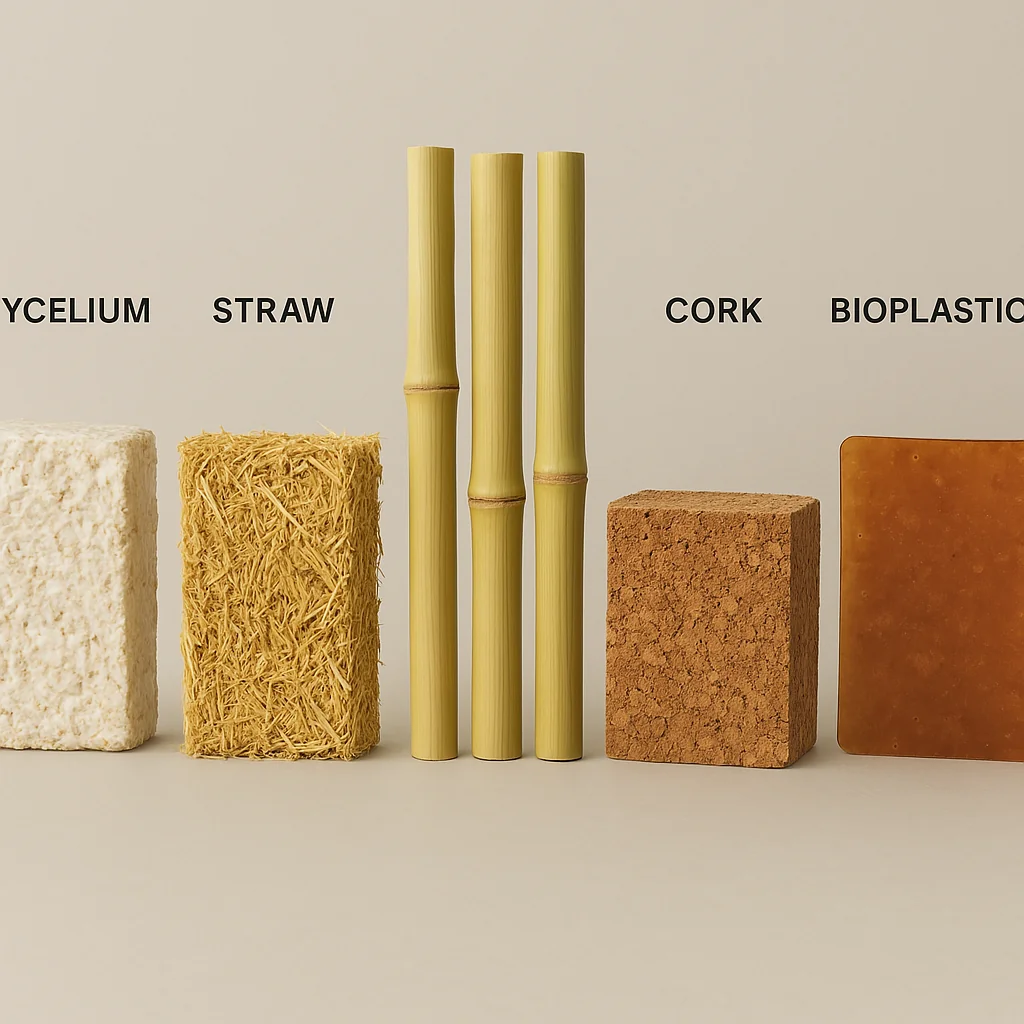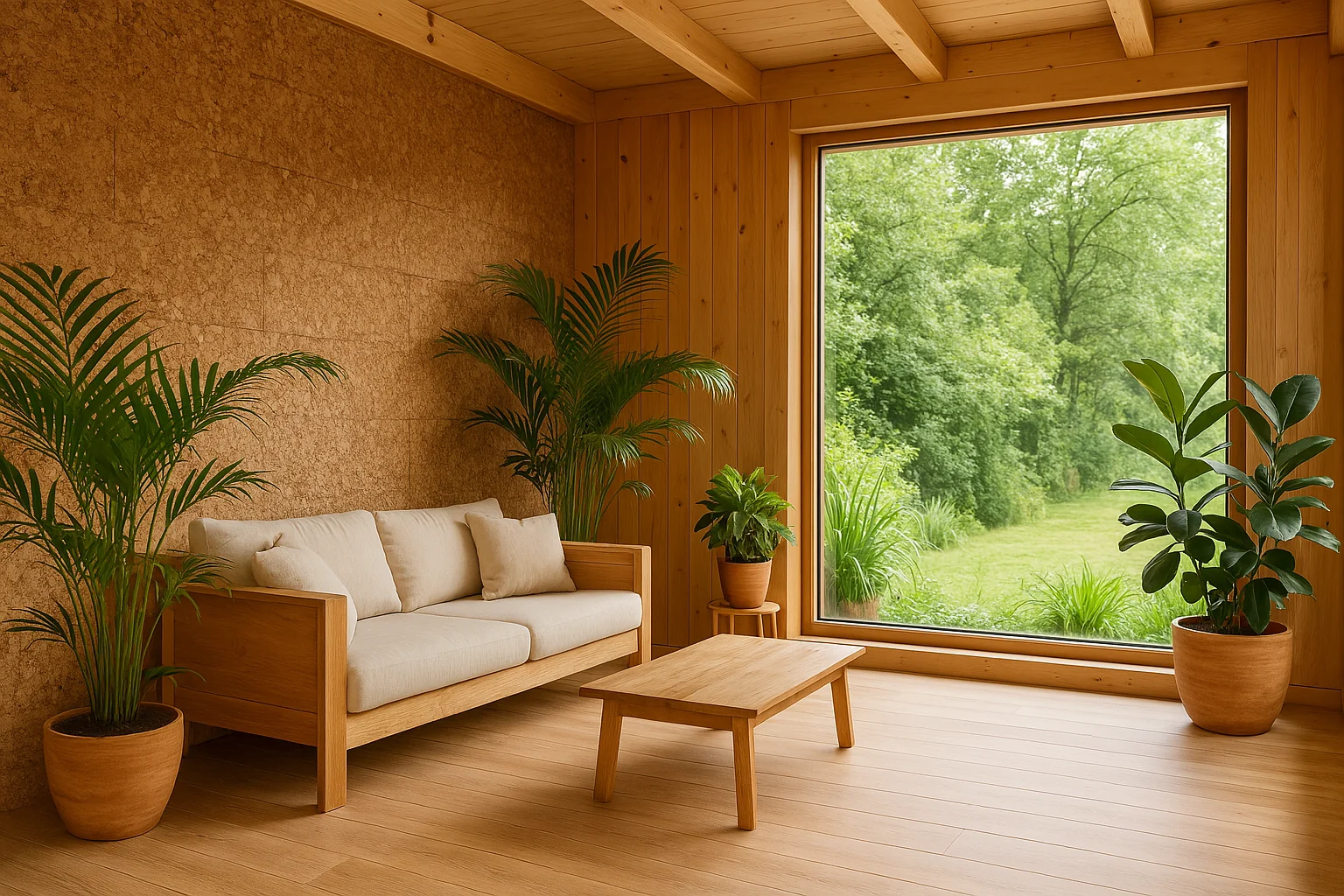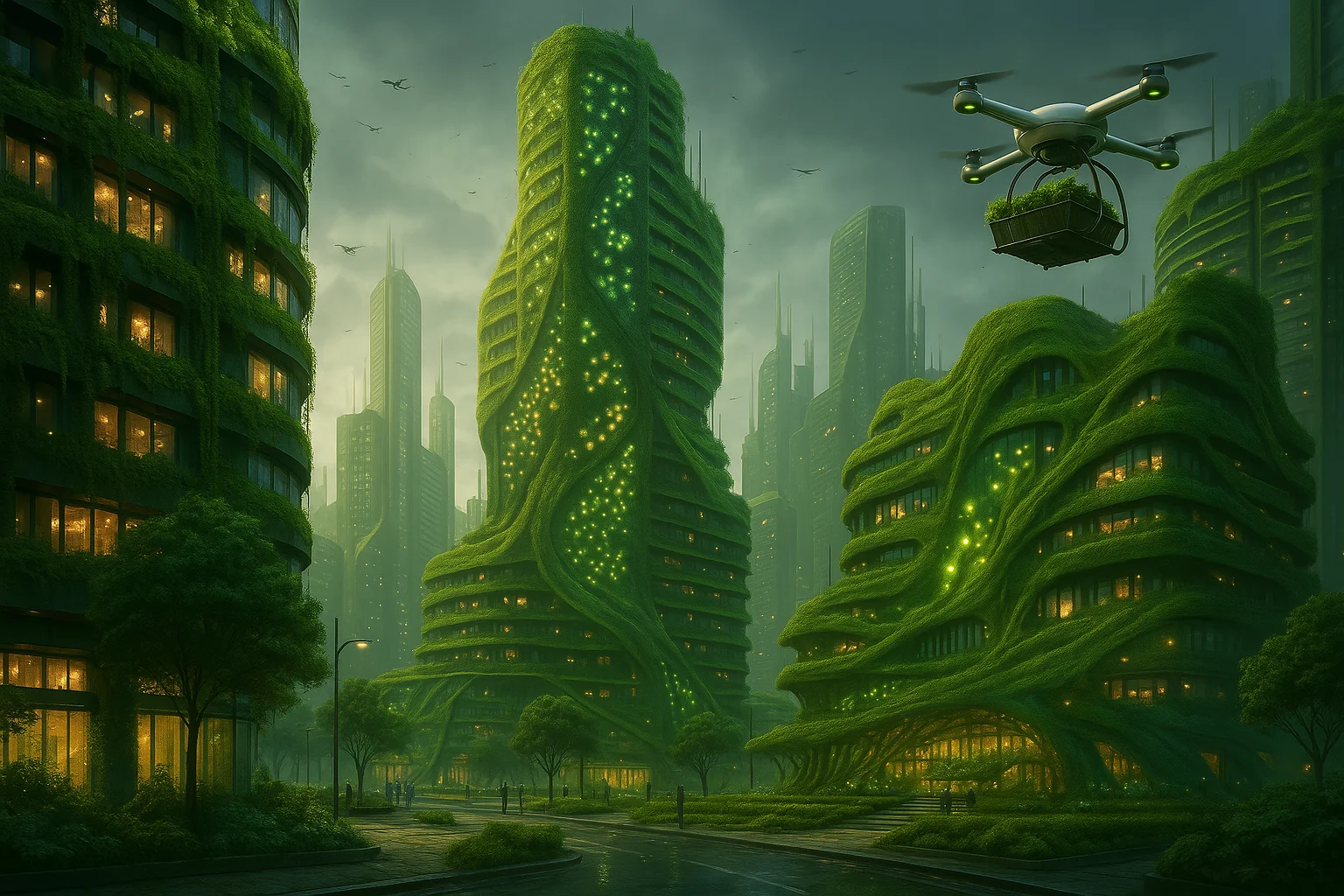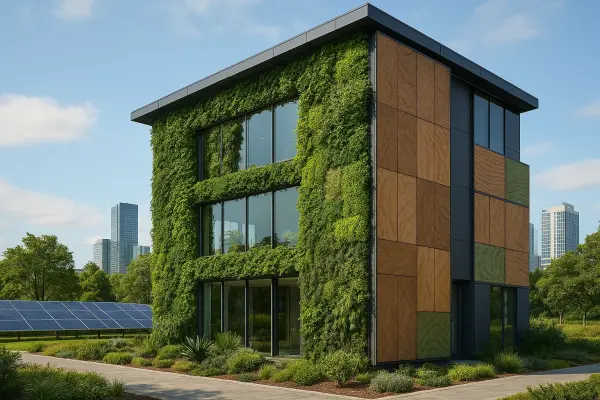In the 21st century, architects and designers are increasingly turning to biomaterials when designing buildings and structures. The popularity of ecological construction is growing rapidly. This stimulates the development of bioarchitecture and the introduction of innovative natural building materials. The integration of biomaterials into architecture is becoming a key element of sustainable architecture of the future, combining aesthetics, functionality and care for the environment. It's worth considering — every year traditional construction produces up to 30% of all greenhouse gas emissions into the atmosphere! Imagine how our planet will change if we can radically reduce this indicator through the widespread introduction of eco-friendly construction.
"The architecture of the future is a symbiosis of technology and nature. Biomaterials allow us to create buildings that not only minimize negative impact on the ecosystem, but also contribute to its restoration. We are building not just houses, but living systems," notes Neri Oxman, architect and materials researcher at MIT Media Lab.
What are biomaterials in construction
Biomaterials are building materials obtained from renewable biological resources or created using living organisms. Biodegradable building materials represent an alternative to traditional materials, possessing environmental friendliness and the ability to completely decompose in the natural environment after the completion of the building's life cycle.
Classification of biomaterials for architectural design

Modern bioarchitecture uses a wide range of organic materials in building and structure design:
| Biomaterial Category | Examples | Application Area | Key Properties |
|---|---|---|---|
| Plant fibers | Wood, bamboo, flax, hemp, straw | Frames, floors, insulation, finishing | High strength, low thermal conductivity, renewability |
| Microbial materials | Mycelium composites, bacterial concrete | Blocks, panels, self-healing structures | Regeneration, biodegradability, adaptability |
| Biocomposites | Hemp concrete, cork boards, nanocellulose | Walls, floors, soundproofing, insulation | Resource efficiency, environmental friendliness, strength |
| Living materials | Photosynthetic facades, bioluminescent coatings | Facades, air purification systems, lighting | Active environmental interaction, self-reproduction |
| Recycled biomaterials | Reclaimed wood, bioplastics | Finishing, small architectural forms | Circular economy, waste reduction |
This classification demonstrates the diversity of available biomaterials for modern architectural planning. It's important to note that many of these materials can be combined, creating hybrid solutions with optimal characteristics for specific projects.
Advantages of using biomaterials in architectural planning
The integration of biomaterials into architecture provides significant advantages when creating eco-friendly construction and sustainable design. It should be considered that research shows: biophilic design using natural materials can not only improve the technical characteristics of buildings, but also positively influence people's psychological state, making the space more harmonious:
- Reduction of carbon footprint through CO₂ absorption by plants from which materials are obtained
- Improvement of thermal insulation properties and natural humidity regulation in rooms
- Creation of a healthy indoor environment without toxic emissions, contributing to biophilic design
- Energy savings for heating and cooling due to passive material properties
- Construction of eco-houses with minimal impact on landscape and ecosystems
- Possibility of implementing circular economy principles in architecture
- Increasing durability of organic materials through innovative treatments
- Improvement of sound insulation properties of biomaterials compared to traditional analogues
The thermal conductivity of biomaterials is on average 30-40% lower than traditional building materials. This makes them an ideal solution for passive houses from biomaterials striving for energy autonomy.

Innovative directions in the use of biomaterials
Modern architectural planning actively researches new methods of using biomaterials, expanding the boundaries of traditional construction. Bio-inspired design and principles of biomimetics in construction open amazing possibilities for architects:
- Biofabrication of architectural elements using microorganisms
- Creation of symbiotic materials capable of self-healing
- Development of bioreactors in construction for energy production
- Implementation of bio-inspired design principles in form-making
- Application of smart biomaterials with shape memory and adaptive properties
- 3D printing from biodegradable composites to create complex architectural forms
These innovative approaches allow creating living walls and facades that not only serve structural purposes, but also actively interact with the environment, improving air quality and microclimate in cities.
"We are at a critical point in the development of the construction industry, when biomaterials are transforming from an exotic experiment into mainstream. Natural composites in architecture are already demonstrating superior technical characteristics compared to traditional materials, while simultaneously solving environmental problems," emphasizes Professor Dirk Hebel, expert in sustainable architecture.
Successful examples of biomaterial use in modern buildings
Architectural planning with biomaterials is actively being implemented in international practice. At one of the major construction projects in Europe, it was possible to reduce the carbon footprint by 45% through comprehensive use of biomaterials. Here are several landmark examples of bioarchitecture:
Success story: Hy-Fi Tower in New York
 Imagine a building that is literally grown from mushrooms and after use can return to the soil without a single gram of waste! In 2014, The Living architectural firm implemented such a revolutionary project — the temporary Hy-Fi pavilion at the Museum of Modern Art in New York. The building was constructed from bio-bricks created from mushroom mycelium and agricultural waste. The building material growing process took only five days. And after dismantling the pavilion, all bio-bricks were completely composted, demonstrating the principle of zero-waste architecture. The project received numerous awards for its innovative approach to ecological construction and opened new prospects for the application of mycelium structures in large-scale construction. Today the technology continues to develop, and projects for permanent buildings using improved mycelium composites are already being developed. This example clearly shows where mycelium is used in construction and what potential this unique biomaterial has.
Imagine a building that is literally grown from mushrooms and after use can return to the soil without a single gram of waste! In 2014, The Living architectural firm implemented such a revolutionary project — the temporary Hy-Fi pavilion at the Museum of Modern Art in New York. The building was constructed from bio-bricks created from mushroom mycelium and agricultural waste. The building material growing process took only five days. And after dismantling the pavilion, all bio-bricks were completely composted, demonstrating the principle of zero-waste architecture. The project received numerous awards for its innovative approach to ecological construction and opened new prospects for the application of mycelium structures in large-scale construction. Today the technology continues to develop, and projects for permanent buildings using improved mycelium composites are already being developed. This example clearly shows where mycelium is used in construction and what potential this unique biomaterial has.
Landmark projects using biomaterials
Impressive examples of buildings from biomaterials are being implemented around the world, demonstrating practical application of sustainable architecture principles. These projects don't just represent architectural value — they inspire genuine admiration with their innovation and harmonious combination with nature:
- BIQ House (Hamburg, Germany) — the world's first building with bioreactor facades from microalgae
- Bamboo Sports Hall (Bali, Indonesia) — a sports hall with innovative bamboo construction, demonstrating the possibilities of using bamboo in interiors and building exteriors
- Cork House (United Kingdom) — a residential house built from cork blocks
- MycoTree (Seoul, South Korea) — a self-supporting structure from mycelium composites
- Biohouse (Netherlands) — a residential building using more than 100 different biomaterials
Each of these projects demonstrates how bamboo in modern architecture, cork coverings in interiors and other natural materials can successfully replace traditional building solutions. Simultaneously, unique aesthetics are created and environmental friendliness is increased.
Economic aspects of biomaterial application
When considering the economic efficiency of bioarchitecture, it's important to account for not only initial investments, but also long-term benefits. Considering market specifics, cost comparison with traditional materials shows: although initial costs may be higher, the service life of biomaterials and their energy efficiency create significant advantages in the long-term perspective.
The cost of biomaterials in construction depends on many factors: raw material availability, production technology, project scale. Although some innovative biomaterials may have higher initial costs, the payback of ecological projects is often ensured through:
- Reduced heating and air conditioning costs
- Increased structural service life
- Reduced disposal costs at the end of life cycle
- Access to green certifications and corresponding tax benefits
- Increased market value of eco-friendly objects
Research shows that potential savings on operational costs over a 20-year period can reach 150-200% of initial investments in premium biomaterials. This makes such solutions economically attractive for forward-thinking investors.
Development prospects for the biomaterials market
The biodegradable building materials market demonstrates steady growth. According to analysts' forecasts, by 2030 the share of biomaterials in architecture and construction could grow to 30-35%. Leaders in biomaterial implementation are European Union countries, where stimulating regulatory norms are in effect. A number of countries have introduced "green" standards for new buildings. This promotes the use of renewable resources in architecture. Eco-material manufacturers in Europe are also beginning to actively develop, opening opportunities for local architects and builders to implement innovative projects using 21st century straw houses and other biocomposites.
"The economics of biomaterials goes beyond simple calculations of cost per square meter. We must consider the full life cycle of a building, including social and environmental benefits. Investments in green architecture today are investments in our future," states Michael Pawlyn, founder of Biomaterial Futures architectural firm.
Problems and solutions when working with biomaterials
Despite obvious advantages, the integration of biomaterials into architecture faces a number of challenges:
| Problem | Solution | Technology Examples |
|---|---|---|
| Limited fire resistance of natural materials | Development of biocompatible fire-retardant treatments, combination with fire-resistant components | Biosilicate treatments, intumescent coatings on plant basis |
| Insufficient durability of organic materials | Application of innovative treatment and preservation methods | Wood acetylation, microbial surface modification |
| Limitations on height and scale of structures | Hybrid structural systems, natural fiber reinforcement | CLT/LVL wood, hybrid bamboo-steel frames |
| Instability of natural material properties | Standardization of production processes, quality control | Digital production monitoring, ISO certification of biomaterials |
| High cost of innovative biomaterials | Production scaling, process optimization | Automated mycelium cultivation, vertical bamboo farms |
Technology improvement and growing research in the biomaterials field gradually overcome these limitations. Thus, ecological building solutions become increasingly accessible and functional for various types of architectural projects.
The future of biomaterials in architectural planning
 Imagine a city of the future where buildings don't just stand, but grow, breathe and evolve together with their inhabitants! Sounds like science fiction? But research in the field of renewable resources in architecture brings us closer to this amazing reality. In practice working with clients, requests for integration of "living" elements into projects increasingly arise. Phytodesign and integration of living organisms into building materials are becoming not just theoretical concepts, but practical directions for architecture development:
Imagine a city of the future where buildings don't just stand, but grow, breathe and evolve together with their inhabitants! Sounds like science fiction? But research in the field of renewable resources in architecture brings us closer to this amazing reality. In practice working with clients, requests for integration of "living" elements into projects increasingly arise. Phytodesign and integration of living organisms into building materials are becoming not just theoretical concepts, but practical directions for architecture development:
- Integration of living organisms into building materials to create adaptive buildings
- Development of building metabolism, allowing structures to grow, adapt and self-heal
- Implementation of biodiversity principles in architectural planning
- Creation of self-healing structures based on biological processes
- Development of building material bioproduction directly at construction sites
- Improvement of hybrid biocomposites with enhanced characteristics
Biomaterials with shape memory and nanocellulose in construction are already finding application in experimental projects. This demonstrates that the future of sustainable architecture is not far away. Already now, wooden skyscrapers are ceasing to be fantasy and becoming reality in developed countries.
Conclusions
The application of biomaterials in architectural planning represents not just a trend, but a fundamental shift in approach to creating sustainable architecture. Ecological construction using biodegradable building materials becomes an answer to global environmental challenges. Biophilic design and the use of organic materials in building design allows creating an environment that is in harmony with nature. Secondary processing in construction and circular economy principles complement this picture, forming a holistic approach to the architecture of the future.
Further development of bioarchitecture will be determined by both technological innovations and changes in regulatory framework and public consciousness. The use of renewable resources in architecture will expand as existing biomaterials improve and new types are developed. This makes eco-friendly construction accessible and attractive for an increasing number of clients and architects. Just as digital technologies radically changed our lives over the past two decades, biomaterials are ready to transform the construction industry in the coming years. Don't you want to be among those who first create the history of our planet's sustainable future?

